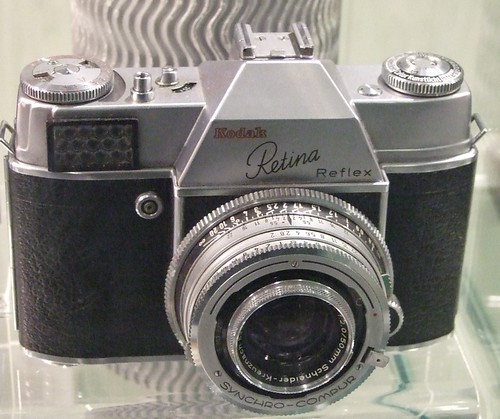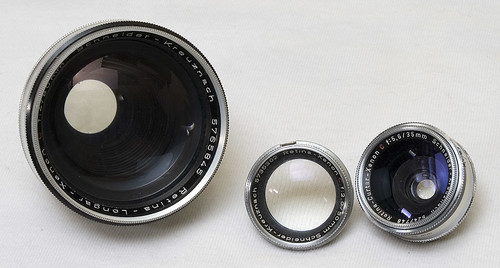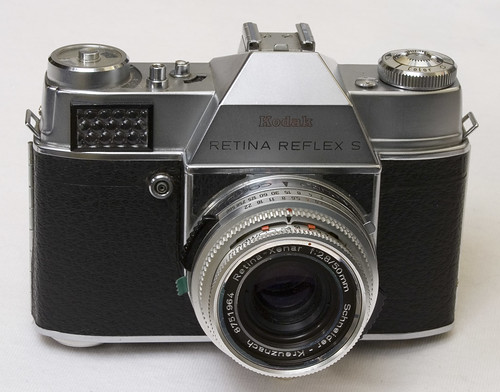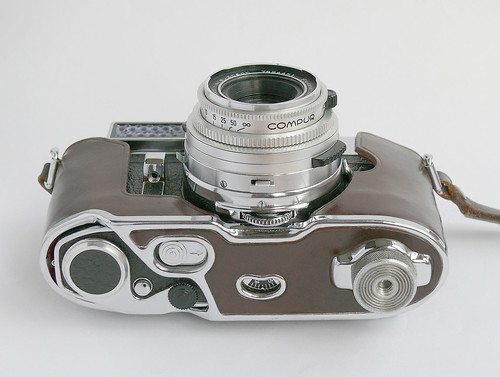Retina Reflex
Contents
Type 025 Retina Reflex

|
| The original Retina Reflex |
The Kodak Type 025 Retina Reflex is a SLR camera with interchangeable lenses made by Kodak AG Stuttgart, Germany. It was made between Spring 1957 and October 1958. Like many SLR cameras of German heritage it works with a leaf shutter instead of a focal plane shutter. It was named Type 025 Retina Reflex since it inherited several features from the viewfinder camera Type 021 Retina IIIc: The film advance and exposure counting system, the film channel, the selenium meter, and the focusing mechanics of the lenses. Even the Synchro-Compur shutter is nearly similar to that of the viewfinder camera. The Retina reflex is basically a fixed-lens camera rear except for one aspect - the front three elements are contained in a cell that bayonets into the front of the lens assembly. The standard front cell can be replaced with one of three Schneider components - an 80mm and two different 35mm components. The rear part of the lens (which is a permanent part of the camera body) contains the focusing apparatus, the entire Synchro-Compur shutter, and the three rear elements, which are common to all 4 lenses. This interchangeable front component concept was very similar to that of the Zeiss-Ikon Contaflex. The Retina Reflex was also available with very similar lenses made by Rodenstock. As the Rodenstock front components were not compatible with the Schneider rear component(and vice versa), minor changes were made to the bayonet mount for each manufacturer.
The camera offered the convenience of image composition with wide open aperture. The aperture is set to the selected value after the shutter is released. After exposure the mirror stays up until the bottom-mounted single-stroke film advance lever is wound.
The non-coupled selenium cell exposure meter reads out in exposure values (EVs) only. The camera is then set to the proper EV setting via an easily reached aperture release tab. The EV scale itself is rather inconveniently located on the underside of the lens assembly. Once the aperture release tab is set and released, the shutter ring is coupled to the aperture ring - moving the shutter ring automatically moves the aperture ring, so that the same exposure value is maintained. In other words, when in use, the camera is normally locked into one EV setting until the aperture release tab is pressed. Needless to say this can be confusing to those unfamiliar with the camera.
Like many SLRs of their era, the Retina Relex cameras are remarkably heavy for their size. The Retina Reflex originally sold for $215 USD[1] (app. $1570 USD in 2007).
Lenses

|
| Schneider interchangeable front components
80mm f/4, 50mm f/2, and 35mm f/5.6 |
The Retina Reflex could be fitted with 4 different lenses. They all shared a common set of three elements at the rear of the lens.
- Schneider-Kreuznach Retina-Xenon C 50mm f/2
- Schneider-Kreuznach Retina-Longar-Xenon C 80mm f/4
- Schneider-Kreuznach Retina-Curtar-Xenon C 35mm f/4
- Schneider-Kreuznach Retina-Curtar-Xenon C 35mm f/5.6
Type 034 Retina Reflex S

|
| The Retina Reflex S
80mm f/4, 50mm f/2, and 35mm f/5.6 |
The Type 034 Retina Reflex S was a major redesign of the original Retina Reflex. The major difference was its use of fully interchangeable lenses, the same lenses that were made for the Kodak Retina IIIS rangefinder camera. The camera mount was commonly referred to as the Deckel mount, which, with minor differences, was also used by a number of other German camera makers, including Braun and Voigtländer. This same lens mount was also used for the later Retina Reflex III, Retina Reflex IV, and the Kodak Instamatic Reflex. Again, lenses were available from both Schneider and Rodenstock, but this time the lenses had identical bayonet mounts.
Lenses for Retina Relex S, II, IV, Instamatic Reflex, And Retina IIIS
- Schneider-Kreuznach Retina-Curtagon 28mm f/4
- Rodenstock Retina-Eurygon 30mm f/2.8
- Rodenstock Retina-Eurygon 35m f/4
- Schneider-Kreuznach Retina-Curtagon 38mm f/2.8
- Schneider-Kreuznach Retina-Xenar 45mm f/2.8
- Rodenstock Retina-Ysarex 50mm f/2.8
- Schneider-Kreuznach Retina-Xenar 50mm f/2.8
- Rodenstock Retina-Ysarex 50mm f/1.9
- Schneider-Kreuznach Retina-Xenon 50mm f/1.9
- Rodenstock Retina-Rotelar 85mm f/4
- Schneider-Kreuznach Retina-Tele-Arton 85mm f/4
- Schneider-Kreuznach Retina-Tele-Arton 90mm f/4
- Rodenstock Retina-Rotelar 135mm f/4
- Schneider-Kreuznach Retina-Tele-Xenar 135mm f/4
- Schneider-Kreuznach Retina-Tele-Xenar 200mm f/4.8
Type 041 Retina Reflex III

|
A later variant is the Type 041 Retina Reflex III. It was made from 1960 to 1964. Its match-needle meter instrument scale is mirrored into the viewfinder. The camera was equipped with coupled selenium meter, since 1962 a bigger one, again made by Gossen. The aperture has to be set with a little wheel underneath the lens. As it was fashion in the early 1960s the shutter release button on top was replaced by a shutter release shifter beside the lens mount. The image below shows that the camera's redesign made a new camera case design necessary, leaving space for that shutter release, and space for the aperture selection wheel. The Retina Reflex case was already something special before since the film advance lever was located on the bottom.

|
Type 051 Retina Reflex IV
The Type 051 Retina Reflex IV was made from 1964 to 1967. It has a characteristic little window in the front of its pentaprism housing. That's the light source for mirroring additional information into the viewfinder.
References
- ↑ History of Kodak Cameras at www.kodak.com
Links

|
| Some photo amateurs know tricks to use the fine lenses of the Bessamatic |
- Retina Reflex III at Camera Collection by Sylvain Halgand
- German article in Schneider-Kreuznach archive
- Retina Reflex section at Retrography.com by Simon Simonsen, Denmark
- Retina Reflex III and IV at Westford.com [1]
- Retina Reflex at "Photography" [2]
- insight into a Retina Reflex of 1958 at "Innovative cameras" [3]